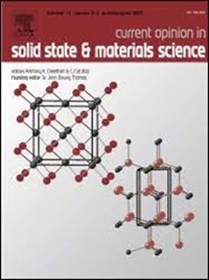Progress and challenges of phase change memory for in-memory computing
IF 13.4
2区 材料科学
Q1 MATERIALS SCIENCE, MULTIDISCIPLINARY
Current Opinion in Solid State & Materials Science
Pub Date : 2025-07-01
DOI:10.1016/j.cossms.2025.101225
引用次数: 0
Abstract
Analog in-memory computing (AIMC) using nonvolatile memories (NVMs) is very promising for achieving low latency and high energy efficiency for deep neural network (DNN) acceleration. There has been significant progress in using phase change memory (PCM) for analog IMC in recent years, especially for DNN inference applications, for both electrical and optical computing. In this paper, we present a review of these works, focusing primarily on PCMs for electrical computing, and including an overview on PCMs for optical computing. For electrical computing using PCM, we review the progress in both the device and the system level. On the device level, we first discuss the impact of PCM characteristics on AIMC computing and introduce relevant benchmarking methods. We then discuss progress in improving PCM devices for AIMC mainly by reducing nonidealities including resistance drift, read noise, and yield. We also discuss progress in programming characteristics that limit the density and programming power. On the system level, we discuss the optimization of memory cells, weight mapping methods, advanced drift compensation algorithms, and co-design considerations. We then review progress in AIMC energy efficiency studies and recent chip demonstrations. Since there is a growing interest in using PCM for photonic computing recently, we give an overview of this area including the device structures and system demonstrations. In the end, we briefly summarize the status and outlook of this field.
面向内存计算的相变存储器的研究进展与挑战
使用非易失性存储器(nvm)的内存模拟计算(AIMC)在实现深度神经网络(DNN)加速的低延迟和高能效方面非常有前途。近年来,相变存储器(PCM)在模拟IMC中的应用取得了重大进展,特别是在电学和光学计算方面的深度神经网络推理应用。在本文中,我们对这些工作进行了回顾,主要集中在电子计算中的PCMs,并包括光学计算中的PCMs的概述。对于使用PCM的电子计算,我们回顾了器件级和系统级的进展。在器件层面,我们首先讨论了PCM特性对AIMC计算的影响,并介绍了相关的基准测试方法。然后,我们讨论了改进用于AIMC的PCM器件的进展,主要是通过减少非理想性,包括电阻漂移,读取噪声和良率。我们还讨论了限制密度和编程能力的编程特性方面的进展。在系统层面,我们讨论了记忆单元的优化、权重映射方法、先进的漂移补偿算法和协同设计考虑。然后,我们回顾了AIMC能源效率研究的进展和最近的芯片演示。由于近年来在光子计算中使用PCM的兴趣越来越大,我们概述了这一领域,包括器件结构和系统演示。最后,简要总结了该领域的现状和展望。
本文章由计算机程序翻译,如有差异,请以英文原文为准。
求助全文
约1分钟内获得全文
求助全文
来源期刊

Current Opinion in Solid State & Materials Science
工程技术-材料科学:综合
CiteScore
21.10
自引率
3.60%
发文量
41
审稿时长
47 days
期刊介绍:
Title: Current Opinion in Solid State & Materials Science
Journal Overview:
Aims to provide a snapshot of the latest research and advances in materials science
Publishes six issues per year, each containing reviews covering exciting and developing areas of materials science
Each issue comprises 2-3 sections of reviews commissioned by international researchers who are experts in their fields
Provides materials scientists with the opportunity to stay informed about current developments in their own and related areas of research
Promotes cross-fertilization of ideas across an increasingly interdisciplinary field
 求助内容:
求助内容: 应助结果提醒方式:
应助结果提醒方式:


